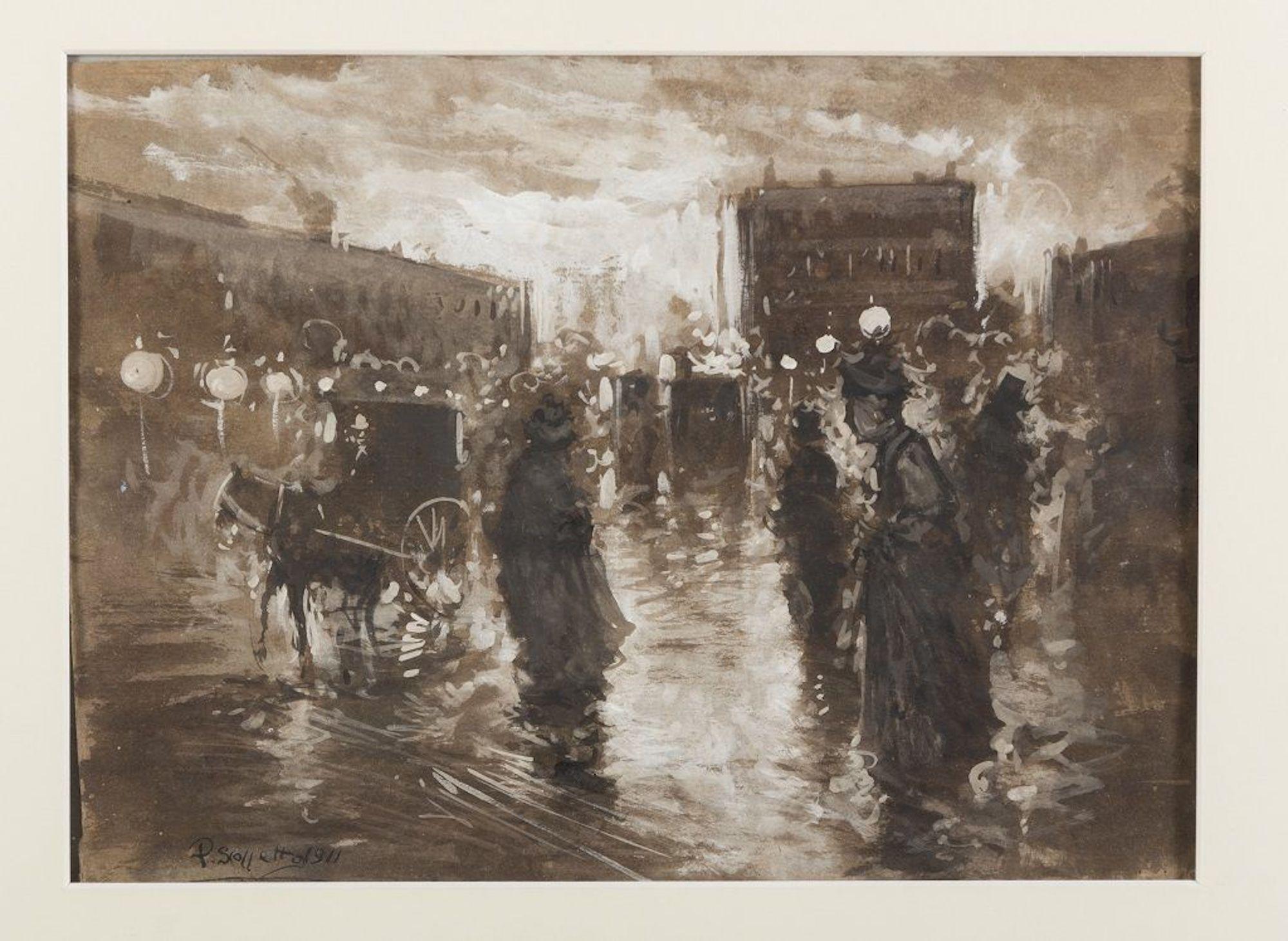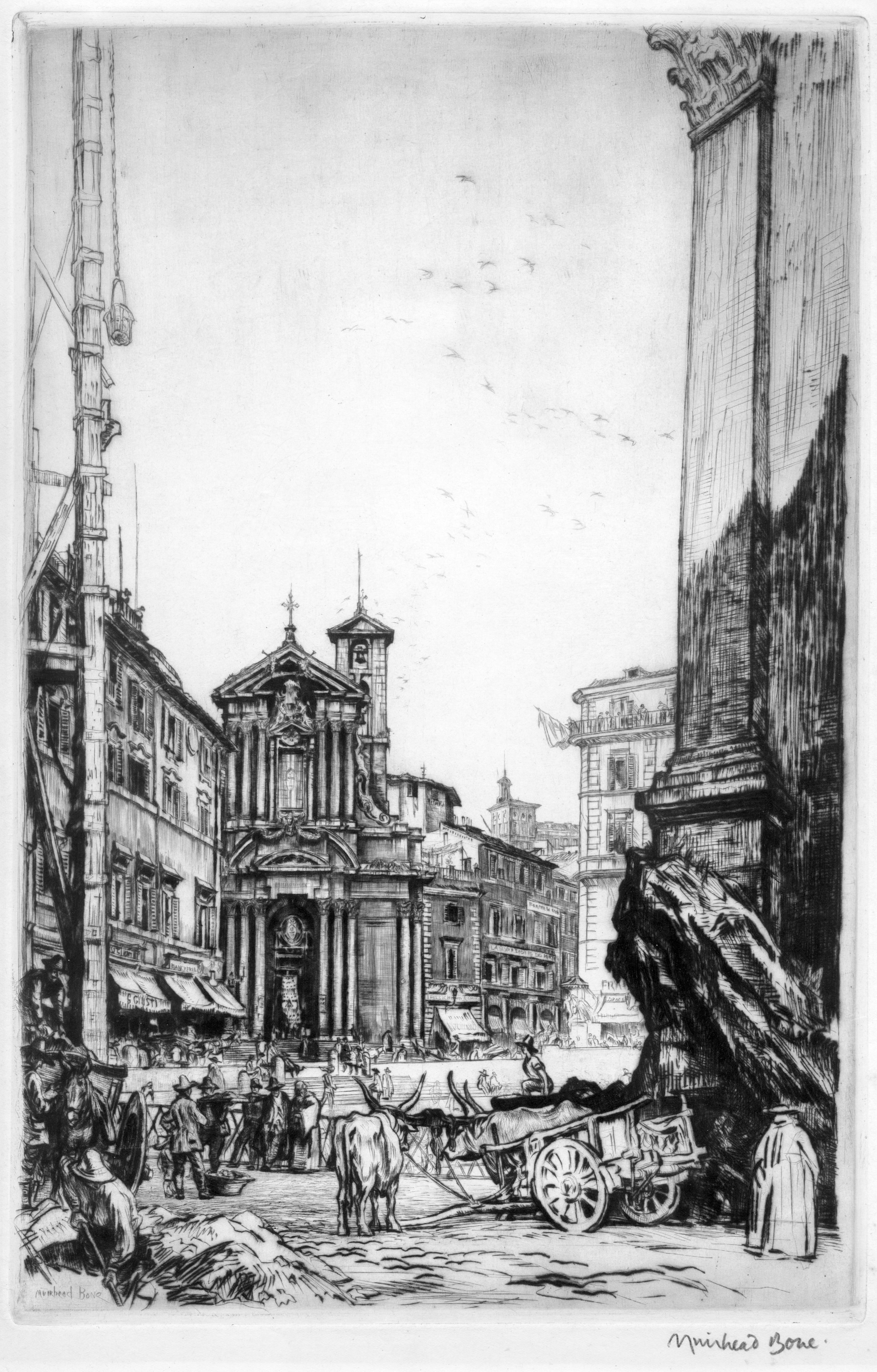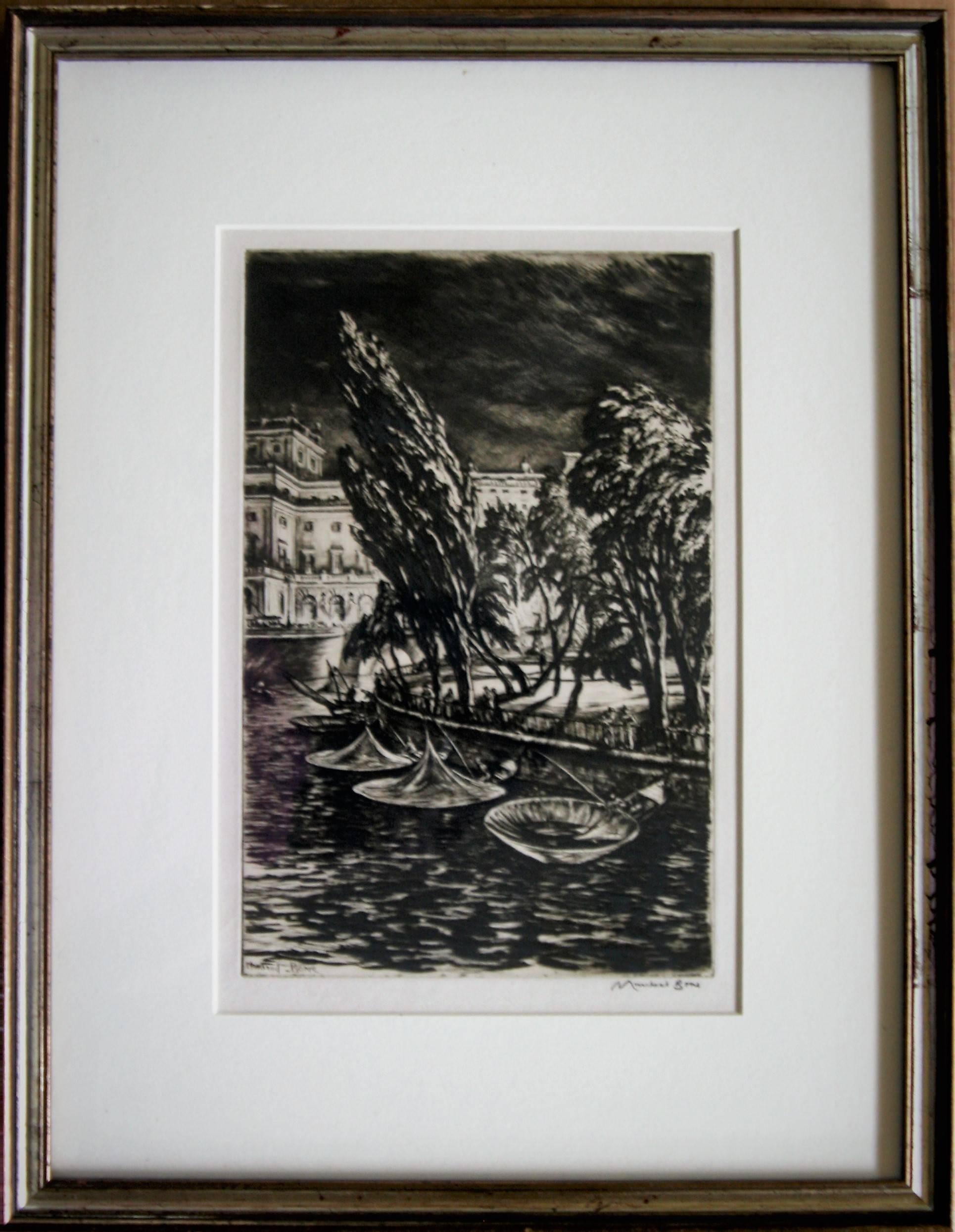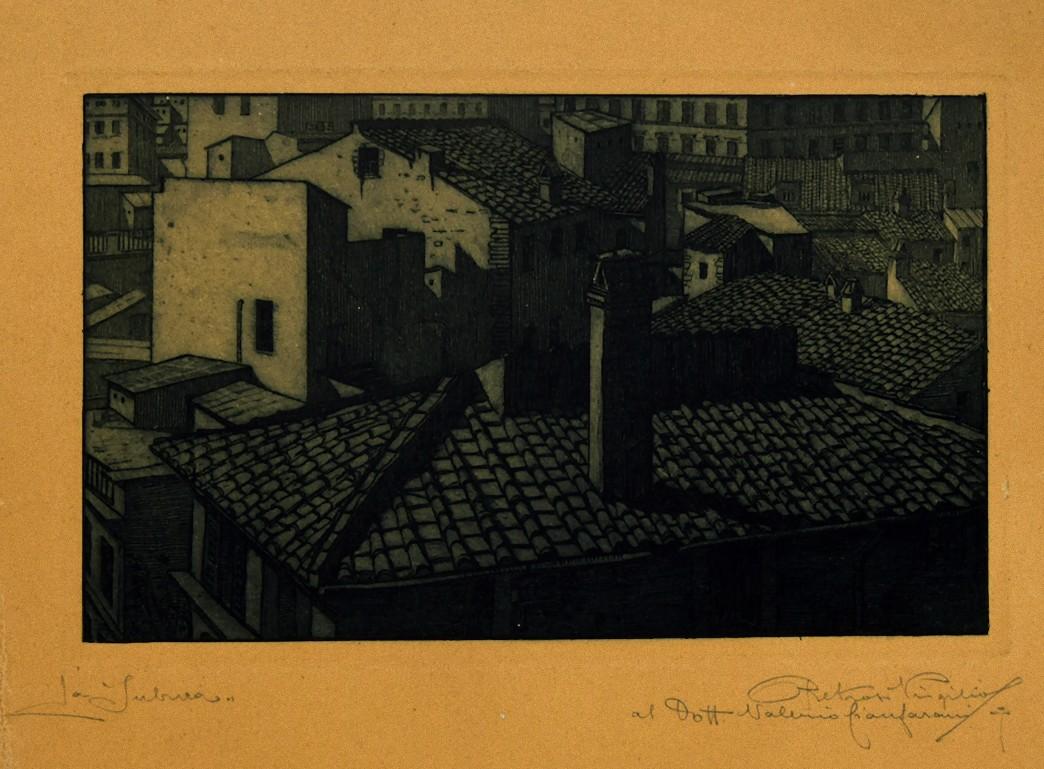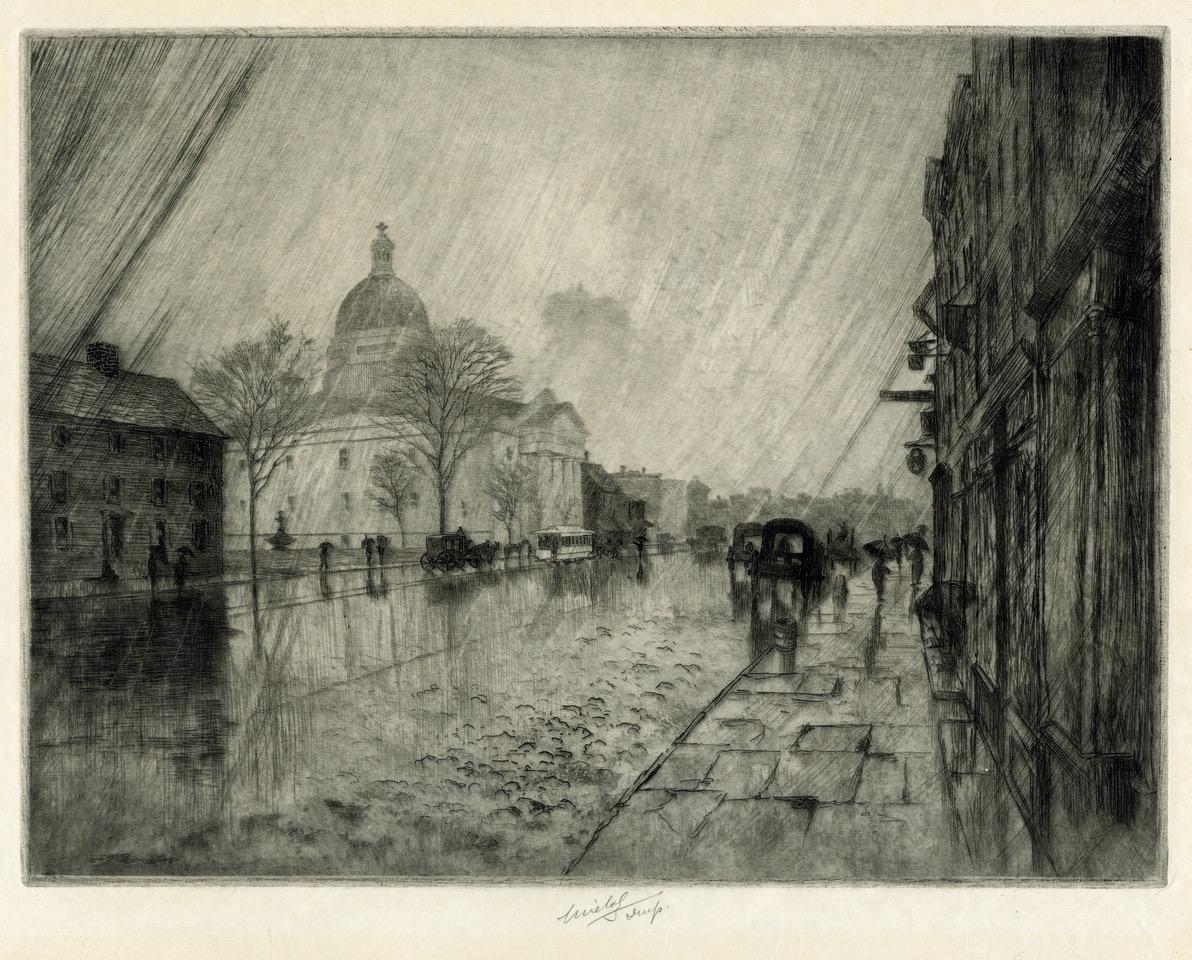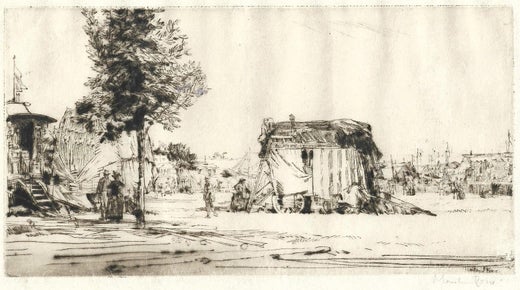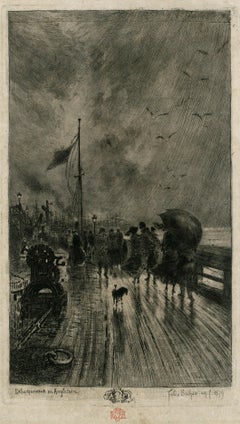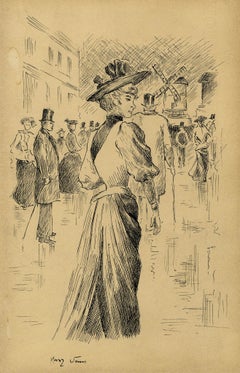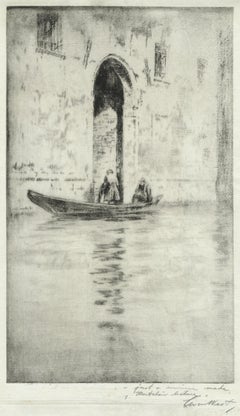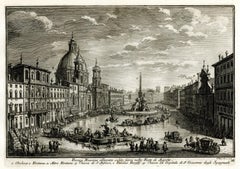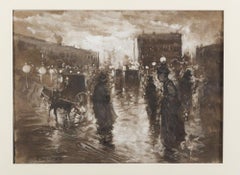Items Similar to Rainy Night in Rome
Want more images or videos?
Request additional images or videos from the seller
1 of 7
Sir Muirhead BoneRainy Night in Rome1913
1913
$2,500
£1,894.22
€2,173.47
CA$3,517.90
A$3,867.14
CHF 2,032.39
MX$46,961.21
NOK 25,353.60
SEK 24,020.75
DKK 16,221.17
About the Item
Rainy Night in Rome
Drypoint, 1913
Signed in pencil and titled in the lower margin by the artist
(see photo)
Provenance:
Kennedy Galleries, Stock # A6538
Reference; Doddgson 299 _/X
Total edition in 10 states 125 printed
Note: The scene depicts the Church of San Rocco on the right at the intersection of via Schiavoria and via di Ripetta. Guichard considers this image to be among the artist's most desirable.
Condition: Exceptional, rich impressions, printing with extensive burr. Printed on a medium weight Japanese paper.
Image/Plate size: 12 x 9 inches
Sheet size: 15 7/8 x 11 inches
Sir Muirhead Bone (23 March 1876 – 21 October 1953) was a Scottish etcher and watercolourist who became known for his depiction of industrial and architectural subjects and his work as a war artist in both the First and Second World Wars.
A figure in the last generation of the Etching Revival, Bone's early large and heavily-worked architectural subjects fetched extremely high prices before the Wall Street Crash of 1929 deflated the collectors' market. He was well known, if not notorious, for publishing large numbers of different states of etchings, encouraging collectors to buy several impressions.
Bone was an active member of both the British War Memorials Committee in the First World War and the War Artists' Advisory Committee in the Second World War He promoted the work of many young artists and served as a Trustee of the Tate Gallery, the National Gallery, and the Imperial War Museum.
Early life
Muirhead Bone was born in Partick, Glasgow. His parents were journalist David Drummond Bone (1841–1911 and Elizabeth Millar Crawford (1847–1886).
The Bone and his siblings attended the local Board school and were placed in apprenticeships from the age of fourteen. James Bone, Muirhead Bone's senior by four years, was apprenticed as a newspaper reporter and went on to become the London correspondent of the Manchester Guardian while David Bone, another older brother, joined the navy and eventually became Commander Master of the Anchor Line and was knighted. Muirhead Bone was initially apprenticed as a painter of porcelain and later as an architect's draughtsman and completed a four-year apprenticeship before immediately turning to art.
Bone studied at the Glasgow School of Art, initially at evening classes. There he befriended the artist Francis Dodd and his sister Gertrude Helena Dodd, to whom he became engaged in 1898 He began printmaking in 1898, his first known print was a lithograph and he is now better known for his etchings and drypoints. His subject matter was principally related to landscapes and architecture, which included urban construction and demolition sites, Gothic cathedrals and Norman buildings. The collection of his prints held by the British Museum contains a number of works based in South Ayrshire, between 1898 and 1916. In 1900 he tried to run art classes in Ayr, from newly built premises at Wellington Chambers.
In 1901 Bone moved to London, where he met William Strang, Dugald MacColl and Alphonse Legros, and became a member of the New English Art Club. He held his first solo exhibition at the Carfax Gallery in 1902 Bone was also a member of the Glasgow Art Club with which he exhibited. In 1903, Bone had finally achieved enough financial success as an artist that he could afford to marry Gertrude, after a five-year engagement. They moved to Chiswick and had their first son, Stephen, in 1904, and their second son, Gavin, in 1907.] Bone continued to visit Ayr, producing the notable prints of Ayr Prison in 1905 and a series based on the view of the Ballantrae Road in 1907.
First World War and interbellum
During the First World War, Charles Masterman, head of the British War Propaganda Bureau, acting on the advice of William Rothenstein, appointed Bone as the first official British war artist in May 1916. Bone had lobbied hard for the establishment of an Official War Artists scheme and in June 1916 he was sent to France with an honorary rank and a salary of £500. Although thirty-eight years old at the outbreak of war, Bone was spared from certain enlistment by his appointment. Bone's small, black and white drawings, and their realistic intensity, reproduced well in the government-funded publications of the day. Where some artists might have demurred at the challenge of drawing ocean liners in a drydock or tens of thousands of shells in a munitions factory, Bone delighted in them; he was rarely intimidated by complex subjects and whatever the challenge those who commissioned his work could always be sure that out of superficial chaos there emerged a beautiful and ordered design.]
Commissioned as an honorary second lieutenant, Bone served as a war artist with the Allied forces on the Western Front and also with the Royal Navy for a time. He arrived in France on 16 August 1916, during the Battle of the Somme and produced 150 drawings of the war before returning to England in October 1916.] Over the next few months Bone returned to his earlier subject matter, producing six lithographs of shipyards on the Clyde for the War Propaganda Bureau's Britain's Efforts and Ideals portfolio of images which were exhibited in Britain and abroad and were also sold as prints to raise money for the war effort He visited France again in 1917 where he took particular interest depicting architectural ruins. Two volumes of Bone's wartime drawings were published during the war, The Western Front and With the Grand Fleet. He was an active member of the British War Memorials Committee and helped select which artists received commissions from the Committee.
After the Armistice, Bone returned to the type of works he produced before the war, and was influential in promoting fellow war artists William Orpen and Wyndham Lewis. He began to undertake extensive foreign travels, visiting France, Italy and the Netherlands, which increasingly influenced his work. In 1923 he produced three portraits of the novelist Joseph Conrad during an Atlantic crossing. An extended visit to Spain in 1929 resulted in the folio Old Spain, a collaboration with his wife who wrote the text, which was published in 1936. In the inter-war period he exhibited extensively in London and New York, building up a considerable reputation. Bone received a knighthood in the 1937 Coronation Honours for services to art and he served as a Trustee and on the committees of several institutions including the Tate, the National Gallery and the Imperial War Museum.
Second World War
At the outbreak of the Second World War, Muirhead Bone was appointed a member of the War Artists' Advisory Committee and also became a full-time salaried artist to the Ministry of Information specialising in Admiralty subjects. He produced scenes of coastal installations, evacuated troops and portraits of officers. However, following the death of his son Gavin in 1943, he decided not to continue with the Admiralty commission but he did remain an active Committee member until the end of the war. His other son, Stephen Bone, was subsequently appointed to the vacant Admiralty position
Death
Bone died on 21 October 1953 in Oxford. He was buried in the churchyard adjacent to the St. Mary's Church, Whitegate at Vale Royal parish in Cheshire. He has a memorial stone in St. Paul's Cathedral in London.
Courtesy Wikipedia
Campbell Dodgson, Etchings and Drypoints by Muirhead Bone (London: Orbach & Co., 1909), 299 __/X, total edition of 125 printed in 10 states.
- Creator:Sir Muirhead Bone (1876 - 1953, Scottish)
- Creation Year:1913
- Dimensions:Height: 12 in (30.48 cm)Width: 9 in (22.86 cm)
- Medium:
- Movement & Style:
- Period:
- Condition:Exceptional, rich impressions, printing with extensive burr. Printed on a medium weight Japanese paper.
- Gallery Location:Fairlawn, OH
- Reference Number:Seller: FA92541stDibs: LU14015913952
Sir Muirhead Bone
Muirhead Bone was born in Partick, a suburb of Glasgow in 1876. As a young man he was apprenticed to a firm of architects and in the evenings attended classes at the Glasgow School of Art. Aware his vocation was art, and not architecture, he devoted his time almost exclusively to drawing. He continually sketched the streets, buildings, and slums of Glasgow imbuing the urban decay with dignity and sentiment he so admired in the work of the Dutch artists whose townscapes he had studied in the Glasgow Corporation Art Galleries. Bone moved to London in 1901, holding his first exhibition at the Carfax Gallery in 1902. His success both critically and financially was rapid. His status as an etcher in the early years of the last century placed him among the world's most celebrated artists. It is not an exaggeration to say that his international reputation among collectors and the curators of the 'Great Print Rooms' of Europe and America was without parallel. He was appointed the first Official War Artist in World War I and was the doyen of War Artists in the Second World War. He was instrumental in the foundation of The Imperial War Museum, and became a Trustee of The Tate and The National Gallery. He was knighted for his services to art in 1937
About the Seller
5.0
Recognized Seller
These prestigious sellers are industry leaders and represent the highest echelon for item quality and design.
Platinum Seller
Premium sellers with a 4.7+ rating and 24-hour response times
Established in 1978
1stDibs seller since 2013
813 sales on 1stDibs
Typical response time: <1 hour
Associations
International Fine Print Dealers Association
- ShippingRetrieving quote...Shipping from: Fairlawn, OH
- Return Policy
Authenticity Guarantee
In the unlikely event there’s an issue with an item’s authenticity, contact us within 1 year for a full refund. DetailsMoney-Back Guarantee
If your item is not as described, is damaged in transit, or does not arrive, contact us within 7 days for a full refund. Details24-Hour Cancellation
You have a 24-hour grace period in which to reconsider your purchase, with no questions asked.Vetted Professional Sellers
Our world-class sellers must adhere to strict standards for service and quality, maintaining the integrity of our listings.Price-Match Guarantee
If you find that a seller listed the same item for a lower price elsewhere, we’ll match it.Trusted Global Delivery
Our best-in-class carrier network provides specialized shipping options worldwide, including custom delivery.More From This Seller
View AllUn Debarquement en Angleterre (A Disembarking in England)
By Félix Hilaire Buhot
Located in Fairlawn, OH
Un Debarquement en Angleterre
(A Disembarking in England)
etching, drypoint, aquatint, roulette and spirit ground, 1879
Signed with the artist’s red owl stamp, Lugt 977 (see photo)
...
Category
1870s Impressionist Landscape Prints
Materials
Drypoint
Night Life at the Moulin Rouge
By Henry Somm
Located in Fairlawn, OH
Night Life at the Moulin Rouge
Pen and ink drawing, c. 1890
Signed lower left (see photo)
A scene of the night life near the Moulin Rouge, Paris. The Moulin Rouge is the famous caba...
Category
Late 19th Century French School Drawings and Watercolor Paintings
Materials
Ink
Untitled (Venice canal, man departing the gondola)
By Levon West
Located in Fairlawn, OH
Untitled (Venice canal, man departing the gondola)
Drypoint, c. 1930-1931
Signed in pencil lower right (see photo)
Annotated in the lower margin:
"Just a souvenir made ___ Monclair L...
Category
1930s American Impressionist Landscape Prints
Materials
Drypoint
Piazza Navona allagata solito farsi nelle Feste di Agosto
By Giuseppe Vasi
Located in Fairlawn, OH
Piazza Navona allagata solito farsi nelle Feste di Agosto
Etching, 1752
Signed in the plate lower right (see photo)
From: Della Magnificenze di Roma Antica e Moderna ( The Magnificense of Ancient and Modern Rome) , (1747-1761)
Volume II, The Main Squares and Obelisks, columns and other ornaments, 1752, Plate No. 26
Della Magnificenze di Roma Antica e Moderna_ (1747-61), a collection of 238 plates that was published in ten volumes. Vasi recorded all types of architecture and organized these images of contemporary Rome by subject, with each volume representing a different category of architecture. This comprehensive project provides one of the most complete views of eighteenth-century Rome
Condition: Excellent
Image/Plate size: 8 .25 x 12.63 inches
Sheet size: 11 x 15 7/8 inches
Vasi was Giovanni Battista Piranesi’s teacher. Piranesi (1720-1778) entered Vasi’s studio as an apprentice at age 20 c. 1740. Piranesi left Vasi’s employment after stabbing Vasi over the perception that Vasi was withholding secrets of the etching process.
Giuseppe Vasi was an Italian engraver and painter born and trained in Sicily. He received a classical education in his hometown of Corleone and trained as a printmaker in nearby Palermo, perhaps under the tutelage of the etchers Antonino Bova and Francesco Cichè. He moved to Rome in 1736, already an established printmaker, and spent most of his career documenting the urban landscape of the city in engravings. Through his patron, the politically and culturally influential Cardinal Troiano Acquaviva d’Aragona, Vasi met other artists working in Rome, such as Sebastiano Conca, Ferdinando Fuga, and Luigi Vanvitelli. He was also influenced by his predecessors, including Giovanni Paolo Panini, Giovanni Battista Falda...
Category
1750s Old Masters Landscape Prints
Materials
Etching
Venise, Nina
By Edgar Chahine
Located in Fairlawn, OH
Venise, Nina
Etching and drypoint, 1923
Signed lower left (see photo)
Titled lower right (see photo)
Edition 100
Edition: 100
Printed on light green chine collee paper
Condition: Exc...
Category
1920s Impressionist Portrait Prints
Materials
Drypoint
Palazzo, Florence
By Rudy O. Pozzatti
Located in Fairlawn, OH
Palazzo, Florence
Etching, engraving, aquatint, soft ground and lift ground, printed in colors from three copper plates. 1954
Signed in pencil lower right (see photo)
Edition 250 plis 10 on Rives wove paper, printed by the artist
Published by The Print Club of Cleveland, No. 33 for 1955
REFERENCE: Geske #32
Condition: Mint
Image size: 9 3/16 x 13 1/8 inches
Impressions of this image can be found in the following museums:
National Gallery of Art, Washington
Toledo Museum of Art
Oberlin, Allen Museum of Art
Cornell Univeristy
Cleveland Museum of Art
Indianapolis Museum of Art
Baltimore Museum of Art
Georgetown University
Indiana Univeristy, Eskenazi Museum of Art
David Museum of Art at Wellesley College
"Painter and printmaker Rudolph Otto "Rudy" Pozzatti was born in Telluride, Colorado, on January 14, 1925. Upon graduation from high school, he received a scholarship to attend the University of Colorado in Boulder where he enrolled as an art major. In 1943, his studies were interrupted by his induction into the U. S. Army. After his discharge in 1946, he re-enrolled in the University of Colorado where he studied under Wendell...
Category
1950s American Modern Landscape Prints
Materials
Aquatint
You May Also Like
A Night in Paris - Mixed Media on Paper by P. Scoppetta - 1911
By Pietro Scoppetta
Located in Roma, IT
A Night in Paris is an original decorative object realized by Pietro Scoppetta in 1911.
Mixed media on paper.
Hand-signed and dated on the lower left corner: Pietro Scoppetta 1911.
A frame is included.
Very good conditions.
Very elegant, beautiful impressionistic work realized in the first years of the XX Century by the important Italian artist Pietro Scoppetta. The work is characterized by a very impressionistic stroke and touch and depicts a scene during a Parisian night. The figures of the woman in the streets are only sketched but we can feel the elegance and the beauty of the Paris during the fin du siècle.
The work has been realized by Pietro Scoppetta (Amalfi, 1863 - Neaples, 1920) an Italian artist. He dedicated himself initially to architectural studies, he abandoned them to form artistically, under the guidance of Giacomo Di Chirico. Resident in Naples, he had the opportunity to live in a climate of strong movements of cultural evolution. Scoppetta decided to leave Italy for abroad, and stayed a long time in London and Paris. In Paris, where he lived between 1897 and 1903, he joined the large group of Neapolitan painters, attracted by the bourgeois suggestions of the Belle Époque, including Lionello Balestrieri...
Category
1910s Mixed Media
Materials
Mixed Media
Evening, Port of Genoa
By Sir Muirhead Bone
Located in Storrs, CT
Evening, Port of Genoa. 1915. Drypoint. Dodgson 337.i/v. 7 5/8 x 9 15/16 (sheet 9 1/8 x 14). Edition of 45 in five states. An exceptionally rich impression with drypoint burr, printe...
Category
1910s Modern Landscape Prints
Materials
Drypoint
$760 Sale Price
20% Off
19th century landscape of rome daily life by fine print master Sir Muirhead Bone
By Sir Muirhead Bone
Located in Milan, IT
Original etching and drypoint, signed in the plate and in pencil in the lower right corner; Dodgson "Etchings and drypoints by Muirhead Bone", Print Collector's Quarterly, 1922, IX, p. 173-200; Mackenzie, British Prints, p. 57; 400 x 278 mm
Superb test with signs particularly rich in beards, a characteristic typical only of the first tests: the pictorial effect is very effective. Small uneven margins. In perfect state of conservation.
Rich of burr drypoint, 1916, printed on cream paper. Good margins all around. In good condition.
Sir Muirhead Bone (23 March 1876 - 21 October 1953) was a Scottish etcher and watercolorist who became known for his depiction of industrial and architectural subjects and his work as a war artist in both the First and Second World Wars. Bone was an active member of both the British War Memorials Committee in the First World War and the War Artists...
Category
1810s English School Landscape Prints
Materials
Etching
Windy Night, Stockholm.
By Sir Muirhead Bone
Located in Storrs, CT
Windy Night, Stockholm. 1935. Drypoint. Dodgson 457.x. 11 7/8 x 7 5/8 (sheet 15 1/2 x 10 7/8). Edition of 80 in this state (total 93 in 10 states). Illustrated: Guichard, British Etc...
Category
1930s Modern Landscape Prints
Materials
Drypoint, Etching
$1,600 Sale Price
20% Off
City in Night - Original Etching on Cardboard - 20th Century
Located in Roma, IT
City in Night is an original etching artwork on cardboard realized by Virgilio Retrosi, a ceramist and engraver pupil of Duilio Cambellotti.
Hand-...
Category
20th Century Figurative Prints
Materials
Etching
Rainy Day, Providence
Located in Middletown, NY
Etching with drypoint on Japan paper, 9 3/4 x 12 3/4 inches (245 x 322 mm), full margins, from an edition of approximately 50. Signed by the artist in pencil, lower center margin, t...
Category
Early 20th Century American Modern Landscape Prints
Materials
Handmade Paper, Drypoint, Etching
